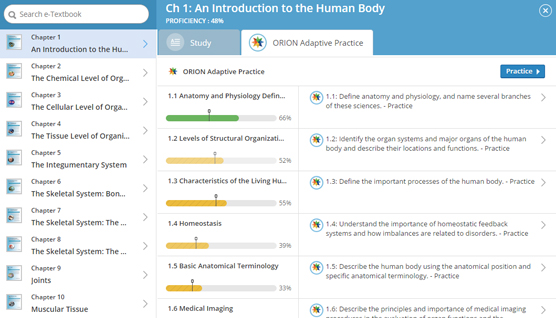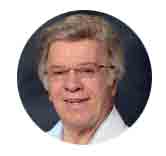
Introduction to the Human Body, 11th Edition
By Gerard Tortora and Bryan Derrickson
Introduction to the Human Body offers a balanced introduction to the human body especially developed to meet the needs of the one-semester A&P course. It provides an effective blend of stunning art and clearly written content to illuminate the complexities of the human body. Class-tested pedagogy is woven into the course with illustrations to ensure that students gain a solid understanding of the material.
The next generation of WileyPLUS for Introduction to the Human Body gives instructors the freedom and flexibility to tailor content and easily manage their course to keep students engaged and on track.
Schedule a Demo Request Instructor AccountWant to learn more about WileyPLUS? Click Here

Adaptive practice helps students effectively prepare for class or quizzes and exams.
Active retrieval of information with practice questions is proven to improve retention of information better than re-reading or reviewing the material, and students who use adaptive practice to prepare for exams do significantly better than those who do not. Students begin with a quick, section-level diagnostic to determine their initial level of understanding, and they can use the dashboard and quick reports to see what topics they know and don’t know.
Physiology resources present the most difficult topics in A&P as identified by instructors.
Three robust physiology resources include the complete set of 15 exciting 3-D animations that present the most difficult physiological concepts as identified by faculty and students.
Robust resources make learning anatomy more accessible.
21 NEW concept lecture animations by Mark Nielson simplify the study of anatomy and help students build a framework of understanding that will help them learn.
What’s New
Introduction to the Human Body enhancements include:- Expanded and Updated: There is physiology coverage across the entire course. New Scanning Electron Microscope (SEM): These images have been added to multiple sections.
- High Quality Dissection Videos: These include 9 cat videos, 8 pig videos, 8 rat videos, 12 human videos.
- 3-D Physiology Animations: These animations cover the 15 most challenging topics for student understanding and are suited for classroom presentation or study use.
- Expanded Customization Capabilities: Course and instructional design services are now available for WileyPLUS users.

Gerard J. Tortora is professor of biology and former biology coordinator at Bergen Community College in Paramus, New Jersey, where he teaches human anatomy and physiology as well as microbiology. He received his bachelor’s degree in biology from Fairleigh Dickinson University and his master’s degree in science education from Montclair State College. He is a member of many professional organizations, including the Human Anatomy and Physiology Society (HAPS), the American Society of Microbiology (ASM), the American Association for the Advancement of Science (AAAS), the National Education Association (NEA), and the Metropolitan Association of College and University Biologists (MACUB).
Above all, Tortora is devoted to his students and their aspirations. In recognition of his commitment, he was the recipient of MACUB’s 1992 President’s Memorial Award. In 1996, he received a National Institute for Staff and Organizational Development (NISOD) excellence award from the University of Texas and was selected to represent Bergen Community College in a campaign to increase awareness of the contributions of community colleges to higher education. Tortora is the author of several best-selling science textbooks and laboratory manuals.

Bryan Derrickson is professor of biology at Valencia Community College in Orlando, Florida, where he teaches human anatomy and physiology as well as general biology and human sexuality. He received his bachelor’ s degree in biology from Morehouse College and his doctorate in cell biology from Duke University. Derrickson’s study at Duke was in the physiology division within the department of cell biology, so while his degree is in cell biology, his training focused on physiology. At Valencia, he frequently serves on faculty hiring committees. He has served as a member of the Faculty Senate, which is the governing body of the college, and as a member of the Teaching and Learning Academy, which sets the standards for the acquisition of tenure by faculty members. He is a member of the Human Anatomy and Physiology Society (HAPS) and the National Association of Biology Teachers (NABT). Derrickson’s students nominated him for a campus award known as the “Valencia Professor Who Makes Valencia a Better Place to Start.” He has received this award three times.
1. Organization of the Human Body
2. Introductory Chemistry
3. Cells
4. Tissues
5. The Integumentary System
6. The Skeletal System
7. Joints
8. The Muscular System
9. Nervous Tissue
10. Central Nervous System, Spinal Nerves, and Cranial Nerves
11. Autonomic Nervous System
12. Somatic Senses and Special Sense
13. The Endocrine System
14. The Cardiovascular System: Blood
15. The Cardiovascular System: Heart
16. The Cardiovascular System: Blood Vessels and Circulation
17. The Lymphatic System and Immunity
18. The Respiratory System
19. The Digestive System
20. Nutrition and Metabolism
21. The Urinary System
22. Fluid, Electrolyte, and Acid-Base Balance
23. The Reproductive Systems
24. Development and Inheritance

